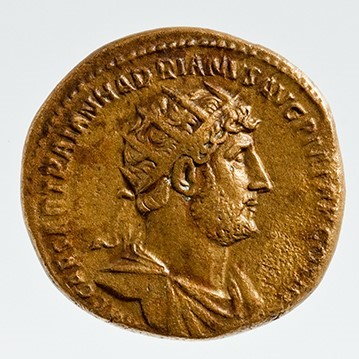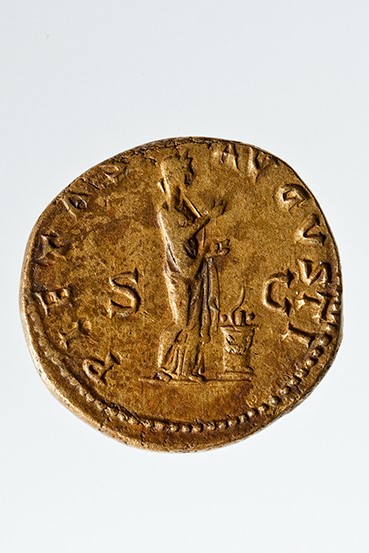Acquisition number: 2007.02
Obv.: Bust of Hadrian r., radiate, draped, cuirassed. IMP(erator) CAESAR TRAIAN(us) HADRIANVS AVG(ustus) P(ontifex) M(aximus) TR(ibunicia) P(otestate) CO(n)S(ul) III.
Rev.: Pietas (dutiful respect) standing r., raising r. hand and holding box of incense in l.; altar at her feet. PIETAS AVGVSTI; across field, S(enatus) C(onsulto).
Title: Dupondius of Hadrian - 2007.02
Acquisition number: 2007.02
Author or editor: Beryl Rawson
Culture or period: Roman Imperial
Date: AD 124
Material: Metal - Brass
Object type: Coins - Roman
Dimensions: 27mm (w)
Origin region or location: Italy
Origin city: Rome
Display case or on loan: 7
Keywords: Coin, dupondius, Roman, Imperial, Hadrian, Pietas
Sear, D.R., Roman Coins and their Values 5 vols (London, Spink, 2000-2014) 3665; Mattingly, H.,Coins of the Roman Empire in the British Museum, 6 vols (London, 1965) 1201 and pl.79.1
2007.02
Dupondius of Hadrian
13.67 g. AD 124
Obv.: Bust of Hadrian r., radiate, draped, cuirassed. IMP(erator) CAESAR TRAIAN(us) HADRIANVS AVG(ustus) P(ontifex) M(aximus) TR(ibunicia) P(otestate) CO(n)S(ul) III.
Rev.: Pietas (dutiful respect) standing r., raising r. hand and holding box of incense in l.; altar at her feet. PIETAS AVGVSTI; across field, S(enatus) C(onsulto).
This coin is from the early period of Hadrian’s reign, soon after his return to Rome from the East in AD 118. From the first year of his reign (AD 117) his coins carried the types of Iustitia (Justice) Pax (Peace) and Pietas (Dutiful respect), heralding key concepts of his reign. Pietas was one of the basic values of Roman public and private life: devotion to the gods, state, and family. It was much used by Augustus and is a prominent feature of second century imperial coinage. Trajan had used this representation of Pietas before Hadrian, and it came to be associated with imperial women (cf. coin 1969.02, of Hadrian’s wife Sabina).
Although Hadrian is following some of Trajan’s types in this early period, he did not adopt the title pater patriae (father of his country) until late in his reign (AD 128).
Sear, D.R., Roman Coins and their Values 5 vols (London, Spink, 2000-2014) 3665; Mattingly, H.,Coins of the Roman Empire in the British Museum, 6 vols (London, 1965) 1201 and pl.79.1

